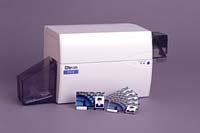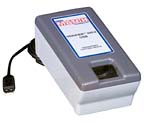ID Systems: The Ins & Outs of Ids
Using a diversity of sophisticated identification technologies, each got what they wanted.
For Baker, electrical designer with Calloway Johnson Moore & West, it is a wander monitoring system for residents of the assisted care living facility that’s part of the Forest at Duke retirement community near Durham, N.C. Appropriate residents wear a wireless transmitter. Control units at monitored doors identify the transmitter when the resident comes within five feet of it. That identification activates the door’s electromagnetic lock and sounds an alarm at the nurse station identification console.
The resident is then kept safe inside the facility.
A professional at the nurse station can authorize exit. A local keypad can also provide access through the door.

Better IDing at Borders
Ridge, on the other hand, sought a way to identify certain people to keep them out of the United States.It was a tall order for the secretary of the U.S. Department of Homeland Security. Ridge and his security technology staff feel they have met the challenge with launch of US-VISIT, an identification program to enhance the nation’s security while facilitating legitimate travel and trade through America’s borders.
The program collects visitor fingerprints digitally, takes a Webcam photo and manages the identification databases while searching the data for matches to terrorists or criminals.
US-VISIT, kicked off last month and aimed at foreign nationals traveling with visas, attracted criticism as well as praise.
“US-VISIT represents the greatest improvement in border inspection in more than three decades, and is a shining example of what we can achieve when government works together,” says Asa Hutchinson, under secretary of border and transportation security. The ID program is actually a continuum of security measures that begins overseas, at the U.S. consular offices issuing visas, where biometrics will be collected to determine if the applicant is on a database of known or suspected criminals or terrorists.
“When the visitor gets to our border, we use the same biometrics – digital fingerscans – to verify that the person at our port is the same person who received the visa or to see if we have learned new information about any involvement in terrorism or crime. This type of identity verification helps our customs and border protection officers make better admissibility decisions and enhances the overall integrity of our immigration system,” Hutchinson adds.
For Sandy Osaki, better use of identification technology allows her to know when employees come in and go out of Clinical Laboratories of Hawaii facility.
Badges Now Integrate
Security is very important to Clinical Labs and all employees are issued identification badges immediately upon employment.“We were using laminated ID badges, but they could not be used with our timekeeping system,” Osaki, human resources education coordinator, says. “We wanted to implement a timekeeping system to facilitate payroll and move from a manual system to an electronic system incorporating the badges.”
Clinical Labs chose a standalone Zebra P310 printer from Zebra Card Printer Solutions, Camarillo, Calif. “The printer’s advantages were its space-saving size, affordability and ability to meet our needs. We print badges almost every day for new employees or to replace lost or damaged badges. The nice thing about the printer is that there is no waste, even if you only need to print one card.”
It’s obvious that Baker, Ridge and Osaki share an appreciation of the strength and versatility of identification systems. At the same time, ID systems continue to evolve as they integrate with imaging, biometrics, physical door controls and even nurse call and timekeeping applications.
Such evolution also calls for more careful ID design.
According to Baker, security systems most often focus on protection of buildings and persons from a diversity of threats. “There are places where a different type of security protection is needed,” Baker adds.
At the Forest at Duke retirement community, with independent and community living in a residential setting, an addition was planned to the community care building to provide assisted living apartments. The challenge for the architect and engineers was to provide a non-institutional setting, while maintaining a closely secured living space.

Intelligent Access Based on ID
The wander monitoring system from Code Alert Inc., Brookfield, Wis., keeps residents in assisted living secure. The monitor system controls access, immediately locking a door on the approach of a resident to within five feet. Each resident has an ankle device that alarms the door on approach, and alarms the nearby nurse station. The device cannot be removed, except by the nursing staff.The control unit also senses and alarms based on “tailgating” by a resident. The lock on exit doors can be defeated by signal from a fire alarm panel or by pushbutton during an emergency.
The assisted living addition is at ground level. There are intrusion sensors at all exterior windows. The building is fully sprinklered; has full smoke detection and fire alarm; and has a nurse assistance call in each resident unit bathroom and bedroom. Activity in an outdoor enclosed garden is monitored by security video through system integration with access control, intrusion and fire alarm via a shared software platform.
Other vendors providing systems and services include: Senior Technologies Inc., Lincoln, Neb.; Instantel Inc., Kanata, ON, Canada; Siemens Building Technologies Inc., Buffalo Grove, Ill., and Simplex-Grinnell, div. of Tyco Inc., Gardner, Mass. System integrator is Edwards Systems Technology Inc. of Sarasota, Fla.
Homeland Security’s US-VISIT program, also based on cutting edge ID technology, covers vastly more ground than Baker’s assistant care facility design.
The new ID entry procedures cover 115 airports and cruise ship terminals at 14 seaports. “US-VISIT is an important new element in the global war against terrorism and will serve as a catalyst in the growing international use of biometrics to expedite processing of travelers,” Secretary Ridge says. Later this year, Homeland Security’s dependence on biometric-based identification systems will expand to visitors who do not need visas to enter the United States. These countries will build a biometrics identifier and digital photo into their citizens’ passports.
The Hawaii application spotlights ID integration. By printing employee badges with barcodes read by Clinical Laboratories of Hawaii’s time and attendance software, the advance “has definitely improved operations, because payroll is now based on an electronic system,” Osaki reports. What’s more, the system has been easy for employees at laboratories on neighbor islands. “When there are new employees on another island, all the site manager has to do is take a digital photo and email it to human resources. Also, when an employee needs to replace a badge that has been lost or damaged, we don’t need to take another photo. The employee is already in the system and a replacement badge can be printed quickly and easily,” she adds.

SIDEBAR: Goodbye Old Mug Shot
The Missouri City, Tex., Police Department is saying goodbye to its traditional mug shot system, replacing it with a Crime Capture System (CCS) from ImageWare, San Diego. The new digital booking, identification and investigative solution will enable police to capture, store and retrieve criminal mug shots, images and data. These images and data can be used to create photo lineups and mug books. The information can also generate wanted posters as well as print employee, visitor or inmate ID cards or wristbands.Looking for a reprint of this article?
From high-res PDFs to custom plaques, order your copy today!








